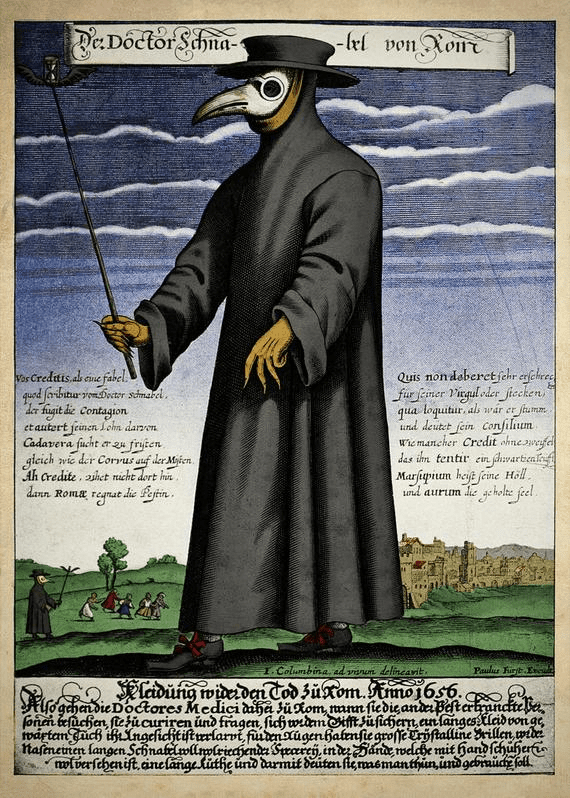Howard Fischer
Uppsala, Sweden

“There are plagues, and there are victims, and it is the duty of good men not to join forces with the plagues.”
– Albert Camus, The Plague
The plague (later called “the black death”) reached Europe from eastern Russia in 1346. By the time the epidemic ended in 1352, one-third of Europe’s population had died.1 The disease is caused by a bacterium, Yersinia pestis, which lives in fleas, and is transmitted to humans by flea bites after a flea has bitten an infected rat. There are two major forms of plague. Bubonic plague is so named because of the very swollen lymph nodes, or buboes, that form during the disease. The patient is sickened and finally killed by the toxins produced by the bacteria. This disease is transmitted to humans by flea bites, as well as by contact with infected victims or contaminated objects. Pneumonic plague results from the inhalation of infective airborne droplets. Within a day or two, cough, chest pain, and the coughing up of blood develop. Death follows in one to six days after symptoms start. Both bubonic and pneumonic plague may lead to septicemic plague, with bacteria and bacterial endotoxins in the blood stream. Bleeding occurs in all organs and tissues because intravascular coagulation consumes all of the patient’s clotting factors.2
A second plague epidemic arose in France in 1628, in Italy in 1656, and in London in 1664.3,4 “Plague doctors,” and the plague doctors’ costume, appeared in the seventeenth century. The plague doctor was hired by cities to treat plague-affected patients, regardless of ability to pay. In many cases they were young physicians, just starting their careers. There were also a number of quacks among them.5 The transmission of the disease was thought to occur via “miasmas,” that is, poisoned air. Ways to reduce contact with contaminated air, which could be inhaled, or could enter through the skin’s pores, were therefore needed. The doctor wore an ankle-length red or black leather coat,6 waxed to prevent any pores or imperfections letting the miasma in. He wore gloves, boots, a hood, and a wide-brimmed hat, the latter the sign of the physician. He also wore—what we now think of when we think of him—a “prototype of 1939 gas masks,”7 with a “beak,” or “snout,” and glass lenses to seal the eye holes. The beak was filled with a number of ingredients, the idea being that good smells would “cancel out” the poisonous miasma. Ingredients included juniper berries, cloves, storax plant resin, dried roses or carnations, peppermint, camphor, wormwood, or garlic. Also used were sponges soaked in vinegar, or the “universal panacea” theriac, which contained fifty-five herbs as well as honey and viper flesh powder.8-10 He also carried a cane, so he did not have to directly touch anyone or anything.
The first report of the use of an herb-stuffed mask was in 1656, the same year that an illustration of the plague doctor in full costume appeared. This outfit was not designed to scare anyone, but to protect the doctor from the plague miasma. The mask had two small holes for breathing, and perhaps the stuffing filtered the air and prevented entry of some droplets. Covering the “whole body in thick leather, leaving no skin exposed” probably gave some protection from fleas.11 Today, Yersinia pestis infections are treated with antibiotics.
References
- “List of epidemics and pandemics.” Wikipedia.
- “Plague (disease).” Wikipedia.
- “Black Death.” Wikipedia.
- Spencer McDaniel. “Plague doctor costumes were actually a good idea.” Tales of Times Forgotten, March 1, 2020.
- “Plague doctor.” Wikipedia.
- Fielding Garrison. An Introduction to the History of Medicine. Philadelphia: W.B. Saunders Company, 1966.
- Richard Gordon. The Alarming History of Medicine. New York: St. Martin’s Press, 1993.
- “Plague doctor costume.” Wikipedia.
- Erin Blakemore. “Why plague doctors wore those strange beaked masks.” National Geographic, March 12, 2020.
- “Plague doctor,” Wikipedia.
- McDaniel, “Good idea.”
HOWARD FISCHER, M.D., was a professor of pediatrics at Wayne State University School of Medicine, Detroit, Michigan.

Leave a Reply